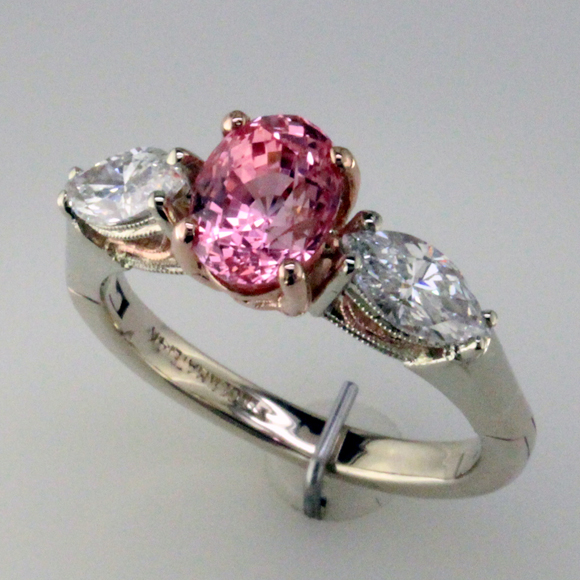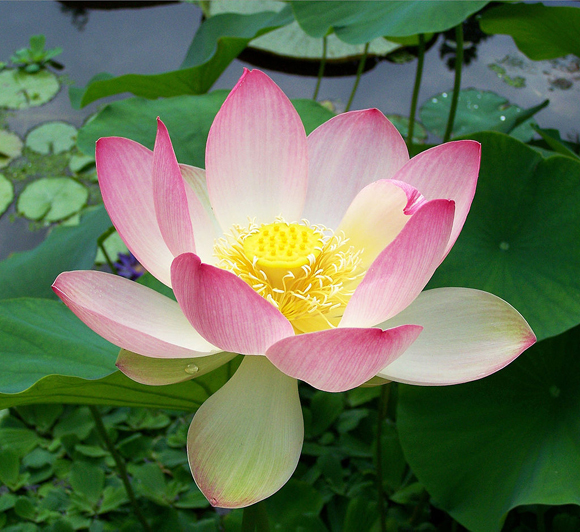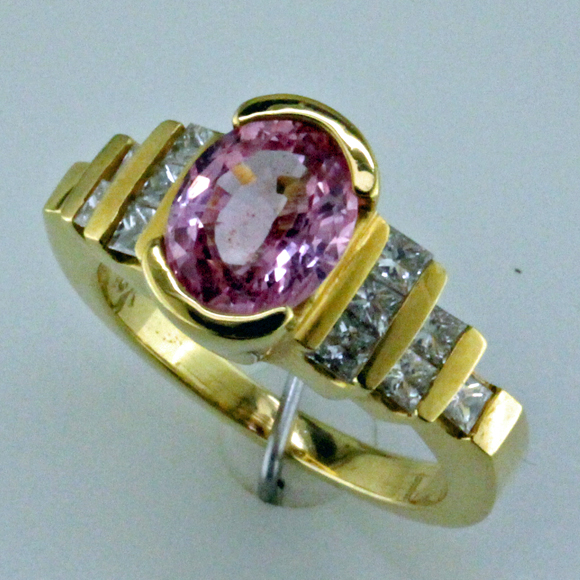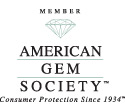Padparadscha or Not- What’s in a Name?
September 3rd, 2014 by James L. Sweaney, CGA, FGA. GGOne of the problems we encounter in the gem trade is misrepresentation to add value to gems. As aficionados of fine gemstones and as members of the American Gem Society and the American Gem Trade Association, we believe it’s important to conduct our business by a strict code of ethics and to protect our customers from fraud and false advertising.
We do this two ways. First, we keep our gemological skills up to date by yearly testing and by following trade publications and scientific journals. We know what we are talking about.
We work diligently to give our customers good information so that they know and understand what they are buying. The following is an example of the subtle differences that can make a big difference to the consumer.
Corundum, one of the most valuable of gem minerals, occurs naturally in almost all the colors of the rainbow. In gemology and the gem trade, the different colors of gem minerals are known as gem varieties.
The red variety of corundum is named ruby; all other colors of corundum are called sapphire. The name sapphire by itself is typically applied to blue corundums, while the other colors are known as fancy sapphires.
These names are important because they are part of the value equation for these gems. Some of the names are descriptive terms. For example, Pigeon’s Blood ruby is a very intense pure red with a hint of violet and no brownish overtones.
The most well known blue sapphire is Cornflower blue, a term applied to the soft rich velvety blue sapphires from Kashmir.
The most exotic and rare of the fancy sapphires is the variety named Padparadscha. The name is derived from the Sanskrit words for the color of the Sacred Lotus. Like Pigeon’s Blood Red and Cornflower Blue, the name Padparadscha has become well known and denotes quality, rarity, and value.
Padparadscha is sapphire that has both pink and orange hues. Our blog article, What is the True Padparadscha, discusses the definition of the color in some detail. The classic description given by GIA’s Robert Crowningshield is a range of color “limited to light to medium tones of pinkish orange to orange-pink hues” with the stipulation that the color should be delicate. I think of Padparadscha as the soft colors of sunset and sunrise where pink is gently warmed by the golden light of the sun.
We recently saw this sapphire ring which had been represented as Padparadscha.
To our eyes, the sapphire, while beautiful, had none of the orangy tones of the Padparadscha. The color is more of a purple pink than orange pink. The piece was accompanied by an elaborate appraisal that used the term “Padparadscha” repeatedly. It appraised the ring at a very high dollar figure – $10,000 – in our opinion grossly overstating the value.
The 2.33 ct sapphire shown at the beginning of the article has been certified by both the Gemological Institute of America and the American Gem Trade Association as being Padparadscha. We’re certain that any gemologist or gem trader would call it a Padparadscha.
On the other hand, while the color differences are subtle, we think most gem experts would call the stone in question a pink sapphire. As such, it’s value would be less– which is the essence of the problem.
We recommend caution when buying rare gems, particularly in today’s world of free flowing information. Deal with a professional jeweler you know or can check out directly, preferably within your community. Ask yourself “How easy will it be to get my money back if I want to return it?”
Next, beware of the seller who offers you something at a price a lot less than an appraisal document. It may feel good to buy a $10,000 item for $1,000 but use common sense. Ask yourself “Why would a business sell me something for a fraction of what they say it’s worth?” If a business starts out with a dishonest statement, can you trust them for anything other than taking your money?
Finally, ask for a gemological certificate of identification from one of top gem labs. For colored stone identification and origin reports, we recommend GIA, and AGL. In addition to the standard identification, the AGL of New York also grades the quality of the gem– an excellent document that gives an independent opinion of quality. The European Gubelin GemLab and the SSEF of Switzerland are also excellent.
Remember though, the certificate is not the gem. Certificates are meant to be an aid in the identification and appraisal of the gem, not to be the main selling tool. Legitimate sellers sell on the basis of their personal taste and expertise based on years of experience and their network of suppliers. The jeweler’s expertise and reputation are more important than the piece of paper.
As always, at Mardon, we are here to serve our loyal customers. Our reputation for expertise, fairness and honesty is backed by 43 years of doing business in the community. With the internet, we’ve been able to expand our reach to all corners of the US, but our business will always be based on satisfied customers who return again and again. We hope you’ll consider us your family jeweler.
Tags: AGL, AGS, Cornflower Blue, GIA, Gubelin, kashmir sapphire, Padparadscha, pigeon's blood ruby, pink sapphire











